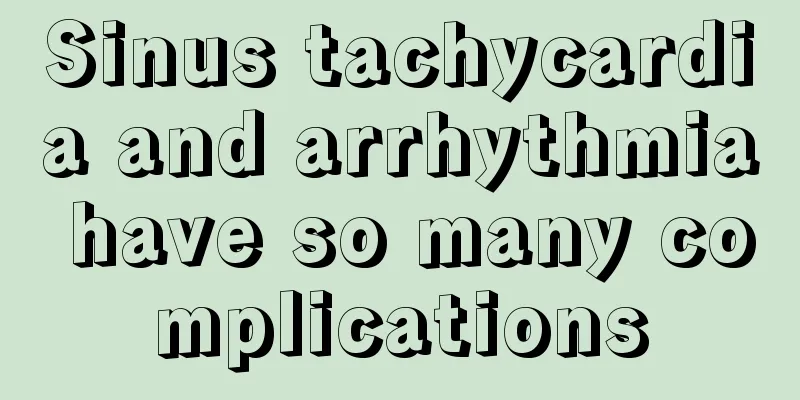Sinus tachycardia and arrhythmia have so many complications

|
Sinus tachycardia and arrhythmia are extremely common diseases in life, and they are also extremely harmful. If not treated in time or treated improperly, they may cause complications, the most common of which are pulmonary edema, heart failure, cardiogenic shock, etc. 1. Pulmonary edema Pulmonary edema is an increase in lung water content caused by a disorder in the fluid exchange function between blood vessels and tissues in the lungs. This disease can seriously affect respiratory function and is a common cause of acute respiratory failure in clinical practice. The main clinical manifestations are extreme dyspnea, orthopnea, cyanosis, profuse sweating, paroxysmal coughing accompanied by large amounts of white or pink frothy sputum, symmetrical moist rales in both lungs, and butterfly-shaped, flake-like fuzzy shadows in both lungs on chest X-rays. Shock and even death may occur in the late stages. Arterial blood gas analysis may show low O2, low CO2 partial pressure, severe O2 deficiency, CO2 retention and mixed acidosis in the early stages. 2. Heart failure Heart failure is divided into left heart failure and right heart failure. The main symptoms of left heart failure are fatigue, dyspnea, which initially occurs during exertion and eventually develops into dyspnea at rest, and the patient can only breathe while sitting up. Paroxysmal dyspnea is a typical manifestation of left heart failure, which often occurs during deep sleep and is characterized by chest tightness, shortness of breath, cough, and wheezing. In particularly severe cases, it can develop into acute pulmonary edema with symptoms of severe wheezing, orthopnea, extreme anxiety, and coughing up foamy mucus (typically pink foamy sputum), cyanosis, and other symptoms of lung congestion. The main manifestations of right heart failure are lower limb edema, distended neck veins, loss of appetite, nausea and vomiting, oliguria, nocturia, and separation of drinking and urination. 3. Cardiogenic shock Cardiogenic shock refers to a syndrome in which the cardiac function is extremely impaired, resulting in a significant decrease in cardiac output and causing severe acute peripheral circulatory failure. The main clinical manifestations are severe underlying heart disease symptoms. Symptoms of systemic circulatory failure include persistent hypotension, oliguria, impaired consciousness, peripheral cyanosis, etc. It may also be accompanied by acute pulmonary edema and changes in hemodynamic indicators, that is, arterial pressure <10.7KPa (80mmHg), central venous pressure may be normal or high, but cardiac output is extremely low. |
<<: How to do health exercises for lumbar disc herniation
>>: How to recover from myopia and astigmatism, tips to restore vision
Recommend
How to use medication in the early stages of teratoma
How to use medication in the early stage of terat...
How to treat viral warts on the feet?
Viral warts are a relatively common skin disease....
How much does a cervical cancer smear screening cost
When it comes to diseases suffered by women, we s...
Causes of breast cancer in women
Breast cancer is a common malignant tumor in wome...
How to repair facial allergies
The term "allergy" is no longer surpris...
What is the reason for swelling around the belly button
Sometimes eating too fast can cause bloating. So ...
What should I do if I feel uncomfortable and want to vomit
In real life, everyone has experienced feeling un...
What are the dietary methods for testicular cancer patients
Some patients with testicular cancer have consult...
Can bone marrow regenerate?
Bone marrow can also regenerate. Bone marrow cell...
TCM classification and treatment of nasopharyngeal carcinoma
TCM believes that nasopharyngeal cancer is mostly...
What should a pregnant woman do if she suffers from melanoma
The high-risk group for melanoma is the elderly, ...
If you have armpit pain, be careful of these diseases
Now people's living standards are gradually i...
How long does it take to remove moisture
Dampness is a very common physiological condition...
There are a few points to note when diagnosing prostate cancer
It is necessary for men to understand the diagnos...
How effective is targeted therapy for advanced liver cancer
Targeted therapy is currently a very important tr...









